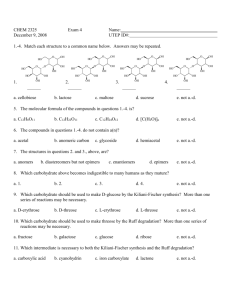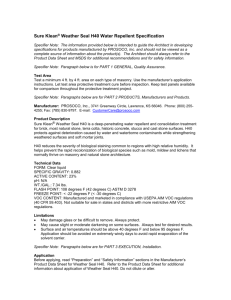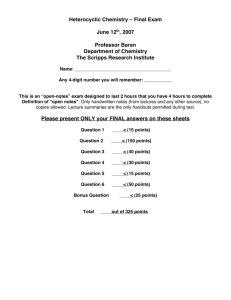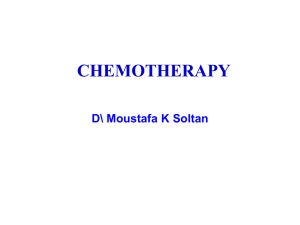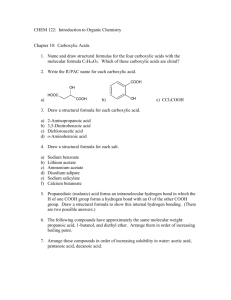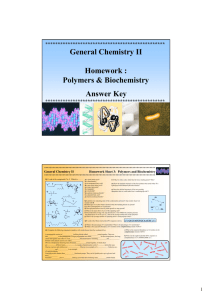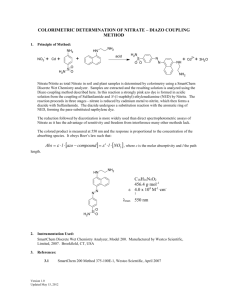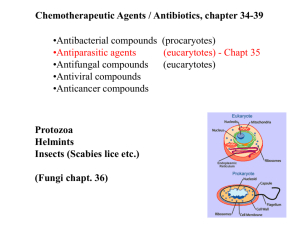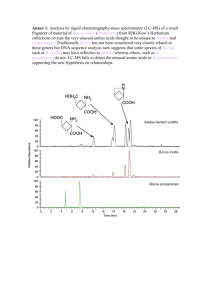Section 3. Antimicrobial Sulfonamides and Antibacterial Synergists
advertisement
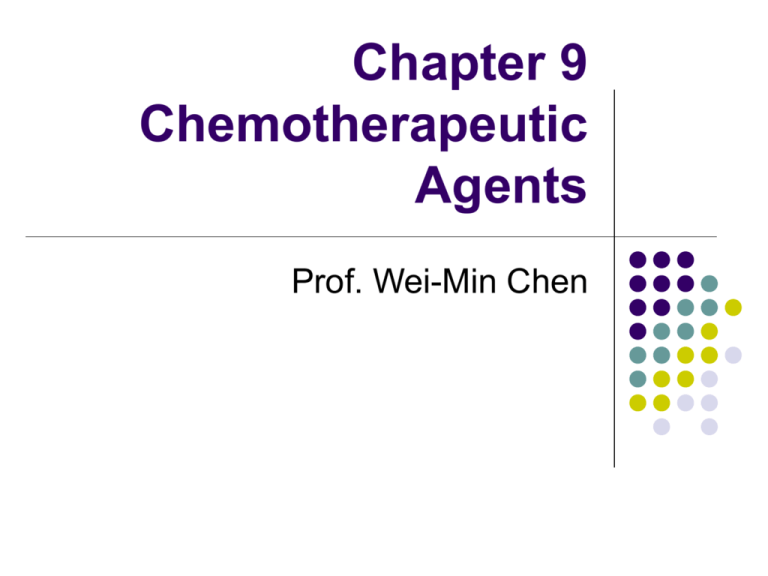
Chapter 9
Chemotherapeutic
Agents
Prof. Wei-Min Chen
Topics in this class
Antimicrobial Sulfonamides and Antibacterial
Synergists
Antifungals Drugs
Section 3. Antimicrobial
Sulfonamides and
Antibacterial Synergists
Sulfonamide Structure
O
O
S
N
H
R
H2N
Sulfonamides
derived
from
p-aminobenzenesulfonamide are commonly referred to as
sulfa drugs. Sulfonamides are synthetic antibacterial
agents with an illustrious history.
In 1935, they were the first class of antibacterial
agents with life-saving potency to be used
systematically for the treatment of bacterial infection,
initiating the era of the sulfa drugs.
Basic Structure
Discovery of Sulfonamides
The discovery of sulfonamides is a significant
milestone event in the human chemotherapeutic
history. Sulfonamides are synthetic compounds
that have activity against both gram-positive and
gram- negative bacteria.
Originally, sulfonamides were synthesized in
Germany as azodyes. In an attempt to expand on
earlier ideas of using dyes as antimicrobial
agents, a man by the name of Domagk
Gerhard Domagk (1895-1964)
German bacteriologist and pathologist who was
awarded the 1939 Nobel Prize for Physiology or
Medicine for his discovery (announced in 1932)
of the antibacterial effects of Prontosil, the first of
the sulfonamide drugs.
The process of discovery for sulfonamides
SO2NH2
SO2NH2
NH2
N N
CH3CONH
N
N
NaO3S
SO3Na
H2N
Prontosil Soluble
Prontosil
NH2
SO2NH2
N
N
H2N
inactive (in vitro)
SO2NH2
Liver
[H]
H2N
active(in vivo)
Mechanism of Action (Wood-fields Theory)
Folic acid
H2N
N
N
N
N
H
N
H
N
O
O
Pteridine
PABA
COOH
COOH
Glutamic acid
The structure of folic acid
Folate Raductase
Folic aicd
Coezyme F
Dihydrofolate Raductase
Dihydrofolic acid
Tetrahydrofolic acid
The biosynthesis of DNA/RNA
O
O
N
HN
O
P
OH
H2N
N
O
O
P
OH
OH
O
N
H
HN2
PABA
SO2NH2
N
HN
COOH
Dihydropteroate synthase
COOH
H2N
NH
N
N
Dihdropteroic acid
Glutamic acid
H2N
O
CONHCHCH2CH2COOH
N
HN
H2N
O
HN
H2N
N
N
H
SO2NH2
N
COOH
NH
Dihydrofolic acid (DHFA)
NH
N
N
H
Dihydrofolate Reductase
(DHFR)
TMP
False Dihdropteroic acid
O
HN
H2N
CONHCHCH2CH2COOH
H
N
NH
N
COOH
N
H
Tetrahydrofolic acid (THFA)
Both the size and distribution of charge of the
sulfonamides and PABA molecule are very similar,
so sulfa drug play a role of metabolism antagonist.
O
0.23
N
nm
O
0.67
nm
H
H
O
0.24 nm RN S
O
N
0.69
H
H
nm
Antimetabolite Theory
Antimetabolites are compounds that prevent the
biosynthesis or use of normal cellular metabolites. The
usually are closely related in structure to the metabolite that
is antagonized. Many antimetabolites are enzyme inhibitors.
They may combine with active site as if they were the
substrate or cofactor.
Structure-Activity Relationship ( SAR )
other aromatic rings or introducing other
groups into the benzene ring will decrease
or lose the antimicrobial activities
Mono subsitution will enhenced the
potency; heterocyclic rings have
better activities; Bis substitution
will lose their activites
SO2 NH R
H2N
unsubstituted or potential
amino groupare essential
for antimicrobial activities
sulfonic group must be in the 4 position of aniline;
2 or 4 position substitution will lose the activities;
other amide group will decrease the potency
The metabolism of sulfonamides
sulfonamides
CH3CONH
SO2NHR
CH3CONH
SO2NHR
Liver
Original Drugs
Glucuronic acid
Sulfadiazine (磺胺嘧啶)
O N
O
S
N
H
N
O O
S
H2N
Chemical Name:
N
N
H
N
H2N
4-Amino-N-2-pyrimidinyl benzenesulfonamide
A white powder, slightly soluble in EtOH or CH3COCH3,
insoluble in ether and CHCl3.
Soluble in diluted HCl and Strong base. mp: 255-256C
The drug is one of a few sulfonamides that still used in
clinic.
Silver and Zinc Salts of
Sulfadiazine
The silver and zinc salts of Sulfadiazine is a very
potent antimicrobial in the treatment of burns、scald
and wound infections
OO
OO
S
H2N
S
N
N
Ag
N
N
H2N
N
N
OO
N
S
NH2
Zn
N
»Ç°· à×à¤Òø
Sulfadiazinum Argenticum
N
S
N O
N
H
H2N
OO
»Ç°· à×à¤Ð¿
Sulfadiazine Zinc
»Ç°· ¼×‡f ßò
Sulfamethoxazol
General synthetic methods of sulfonamide
SO2OH
HOSO2Cl
AcNH
AcNH
SO2Cl
AcNH
H2NR'
SO2NHR'
AcNH
ASC
Synthetic methods of sulfdiazine
NH2
N
N
ASC
Sulfdiazine
SOCl2
Sulfamethoxazole( SMZ)(磺胺甲恶唑)
O N
O
S
O
N
H
H2N
Chemical Name:
4-amino-N-(5-methyl-3-isoxazolyl)benzenesulfonamide.
It’s plasma half-life is 11 hours.
The combination of SMZ and Trimethoprim(TMP) (5:1), the
preparation named Sinomin, can increase the potency of
antimicrobial activities. It is mainly used to treatment of urinary
track infection, respiratory track infection and typhoid bacillus (伤
寒杆菌).
Synthesis of Sulfamethoxazole
NH2
ASC
NaHCO3
CH3
N
O
AcHN
SO2NH
CH3
N
O
SO2Cl
AcNH
ASC
Trimethoprim (甲氧苄嘧啶, TMP)
4
N
NH2
H2N 2 N
1
3
1
O
4
5 O
5
O
Chemical Name: 5-[(3,4,5-trimethoxyphenyl)
methyl]-2,4-pyrimidine diamine
TMP inhibits the dihydrofolate reductase (DHFR), so
that the tetrahydrofolic acid can not be biosynthesized,
which is the important materials in the Biosynthesis of
DNA and RNA.
O
O
N
HN
O
P
O
O
OH
H2N
N
P
OH
OH
O
N
H
HN2
PABA
SO2NH2
N
HN
COOH
Dihydropteroate synthase
COOH
H2N
NH
N
N
Dihdropteroic acid
Glutamic acid
H2N
O
CONHCHCH2CH2COOH
N
HN
H2N
O
HN
H2N
N
N
H
SO2NH2
N
COOH
NH
Dihydrofolic acid (DHFA)
NH
N
N
H
Dihydrofolate Reductase
(DHFR)
TMP
False Dihdropteroic acid
O
Folic acid is eseential
for DNA/RNA
HN
H2N
CONHCHCH2CH2COOH
H
N
NH
N
COOH
N
H
Tetrahydrofolic acid (THFA)
Selective toxicity
Where the bacterial enzyme and mammalian enzyme both
efficiently catalyze the conversion of dihydrofolic to
tetrahydrofiolic acid , the bacteria enzyme is sensitive to
inhibition by trimethoprim by up to 40,000 times lower
concentration than the mouse enzyme. This difference
explains the useful selective toxicity of trimethoprim.
TMP is frequently used as a single agent clinically for the
oral treatment of uncomplicated urinary track infection. It
is, however, most commonly used in a 1:5 fixed ratio
with the sulfonamide sulfamethoxazole.
Synthesis
O
O
OH
HO
(CH 3)2SO4
O
O
HO
NaOH
OH
H2SO4
O
OH
O
O
CH3OH
NH2NH2 . H2O
O
O
O
O
O
H2NHN
K3Fe(CN)6
O
O
NH4OH
O
CH3OCH 2CH 2CN
O
N
O
O
NH2
O
N
NH 2
NH 2
H2NC=NH . HNO3
CH 3ONa
O
O
O
N
H2N
N
H2N
N
O
O
O
O
NH2
HN
N
C
NH2 O
O
O
O
O
O
Some 4-substituted derivatives of TMP
NH2
NH2
N
N
H2N
N
OCH3
OCH3
O
N
SCH3
OCH3
OCH3
Tetroxoprim
H2N
OCH3
(ËÄÑõÆÕ
ÁÖ)
ÁÖ)
Metioprim (ÃÀÌæÆÕ
NH2
N
H2N
OCH3
N
Br
OCH3
Brodimoprim (äåĪÆÕ
ÁÖ)
The Brodimoprim has the inhibition
activity 4 times as that of TMP.
Key Notes
•The basic terms about antibacterial agents
•The discovery process of Sulfonamides.
•Mechanism of Action(Wood-fields Theory)
•SAR of Sulfonamides
•The structures of typical drugs
•The synthetic methods of typical drugs
Section 4.
Antifungals Drugs
Antifungal Agents
Fungi are plant-like, eukaryotic organisms. Most
fungi live as saprophytes in soil or on dead plant
materials and are important in the mineralization
of organic matter.
There are 300,000 kinds of fungi, but only 270 of
which cause disease in humans and animals.
These fungi are divided into two classes according
to mycotic illnesses in humans they caused.
Mucocutaneous Fungi : cause skin and hair
infections (shallow infections)
Systemic Fungi : cause visceral infections (deep
infections)
Fungal infections
In recent year, the incidence of fungal infections has
reached alarming proportions. This duo to a number of
factors .
intensive uses of antibiotics
for bacterial infections
surgery operation and
organ transplant
Fungal
Infections
chemotherapy of cancers
immune systems diseses
such as AIDS
The classification of antifungal agents
Antimycotic antibiotics: Polyenes ( Amphotericin B)
Others (Griseofulvin)
Synthetic antifungal
Agents:
Fluorinated pyrimidines (Fluorocytosine)
Azoles
Imidazoles (ketoconazole)
Triazoles (Fluoconazole)
Allyamines (Terbinafine)
Thioureas (Tolnafate)
Others (Ciclopirox)
Mechanism of action
Squalene
Epoxidase
Allyamines; Thioureas
Lanosterol
Azoles
Cytochrome
p
450
14
Demethyllanosterol
Ergosterol
Polyenes; Morphilines
Cell membranes
Grisofulvin
Mitosis( sliding of microtubules)
Cell nucles
Fluorocytosine
Nucleic acid
Antimycotic antibiotics
制霉菌素
Nystatin
OH
OH
HO
O
O
HO
O
OH
OH
OH
OH
OH
O
H
H 2N
OH O
O
HO
OH
HO
O
HO
匹马霉素
O
Pimaricin
H 2N
H
O
OH
O
H
O
H
OH O
O
HO
O
HO
两性霉素 B
Amphotericin
O
H 2N
HO
OH
OH
HO
H
OH O
O
O
OH
OH
OH
OH
O
OH
OH
HO
O
HO
哈霉素
Hamycin
O
H 2N
O
OH
OH
OH
OH
OH
OH
NH 2
O
H
OH
O
OH
O
O
OH
O
HO
HO
O
曲古霉素
H 2N
OH
O
OH
O
O
O
HO
Trichomycin
O OH
OH
NH 2
O
HO
O
OO
OH
灰黄霉素
癣可宁
O
Griseofulvin
O
O
O
Cl
Siccanin
H
O
H
H
Amphotericin B (AMB) (两性霉素B)
OH
HOOC
OH
OH
O
O
OH
OH
OH
OH
O
OH
H
CH3
NH2
O O
OH
OH
AMB was marked in 1951, it is most commonly
antibiotics used to treatment systemic fungal infections
and is the only polyene antibiotic antifungal agents for
injection use.
Mechanism of Action of (AMB)
This kind of antifungal agents act against sensitive fungal by
combining with membrane ergosterols with subsequent alteration in
permeability and loss of essential organic and inorganic cell
constituents.
In mammalian cell membranes, the principal sterol is cholesterol (胆
甾醇), AMB binds approximately times more tightly to vesicles
containing ergoesterol rather than to those containing cholesterol.
Side-effects
The most serious are hypokalemia and distal tubular acidosis. the
Nephrotoxicity has been lessened to some extent by lipidcomplexed formulations.
Azoles
Azoles have emerged as the preeminent
class of antifungal agents for all except the
most life-threatening infections, and even in
these cases highly active new variants are
being developed. The most significant agents
in clinical use are shown in next slide.
Azole Antifungal Agents
Cl
Cl
H5C6 C6H5
Cl
OH
N
Cl
N
N
O
氟康唑
Fluconazole
Cl
O
N
N
N
Cl
H
N
O
酮康唑
Ketoconazole
O
O
O
N
N
N
N
O
N
Itraconazole
H
N
N
伊曲康唑
N
O
O
N
N
N
益康唑
Econazole
特康唑
Terconazole
Cl
H
Cl
Cl
Cl
Cl
O
Cl
N
N
Cl
N
O
ON
N
噻康唑
Tioconazole
昔康唑
Oxiconazole
O
N
H
N
Cl
F
Cl
Cl
N
N
N
F
Cl
N
Cl
O
咪康唑
Miconazole
克霉唑
Clotrimazole
N
H
Cl
N
S
O
N
N
Cl
Cl
Structure-Activity Relationship
From the many series of azoles that have been
reported by diverse groups, several common
structural features emerge: an imidazole or triazole
heme-coordinating group, a halo-substituted
aromatic separated from the azole moiety by two
atoms, and a side chain .
Azoles
R1
N
N
X
(CH2)n C
Ar
n= 0,1
R2
X=N, CH
Beginning in the late of 1960s, an extensive series of
azole compounds have been synthesized and tested for
antifungal activity.Currently, the R&D for antifungal
agents are also focused on this scaffold.
SAR of Azoles
The triazole or imidazole ring are essential
for the activity, the N 3 atom of azole ring
binds to the ferric iron atom in the heme
prosthetic group to provent the activation
of oxygen for insertion into lanosterol.
The activity: X=N > X=CH
the varying of R1 and R2 can be :
R1= OH, or R, R2 formed a 1,3
dioxapetane.
R1
N
N
X
(CH2)n C
R2
Ar
The substitution must on the
N 1 ,other position will lose
the activity
The 2,4 position of aromatic ring
are intruduced eletron withdrawing
group,such as, F,Cl, will increase
antifungal activity.
The mechanism of action of azoles
Inhibition of cytochrome P-450 that catalyzes 14-demethylation of lanosterol to ergosterol,
accumulation of 14-methylated sterols cause
permeability disturbance
Acety l CoA
HO
HO
ÑòëçÞ´¼
Lanosterol
14-È¥¼×»ùÑòëçÞ´¼
14-Demethyllanosterol
Òæ
¿µßòµÈÆä
ËüßòÀà
azoles
HO
Âó½Ç
çÞ´¼
Ergosterol
Econazole nitrate (硝酸益康唑)
1-[2-[(4-chlorophenyl)methoxy]-2-(2,4dichlorophenyl)ethyl]-1H-imidazole Nitrate
It is only slightly soluble in water and most organic
solvents.
Econazole is used as a 1% cream for the topical
treatment of local tinea infection and cutaneous
candidiasis.
Synthesis
Cl
Cl
Cl
ClCH2COCl
Cl
Cl
HO
O
AlCl3
Cl
Cl
H
N
N
CH3ONa
Cl
Cl
Cl
LiAlH4
Cl
Cl
Cl
Cl
Cl
O
HO
N
N
N
N
Fluconazole(氟康唑 )
2-(2,4-Diflurophenyl)-1,3-bis-(1H-1,2,4triazole-yl)-2-propanol
Synthesis
F
F
COOCH3
N
N
N
N CH2X
N
N
N
Mg/THF
N
F
N CH2MgX
F
O
N
N CH2 C
F
F
N
Fluoconazole
N
F
(1) C4H9Li
NH
OH
F
C(CH2Cl)2
(2) (ClCH2)2CO
F
N
N
N
F
OH
N
Br
(1) Mg, THF
N
(2)
O
N
N CH2 C CH2 N
N
N
Ketoconazole (酮康唑)
N
N
O
Cl
O Cl
H CH2O
N
NCOCH3
Cis-1-acetyl-4-{4-[(2-(2,4-dichlorophenyl)-2-(1Himidazole-1-yl- methyl-1,3-dioxolan-4yl)methoxy]phenyl}piperazine
Ketoconazole was marked in 1981 in US. It is a broadspectrum antifungal activity, used to the treatment of skin
fungi infections and intestinal yeast infections.
The Others
N
N
N
萘替芬
特比萘芬
布替萘芬
Naftifine
Terbinafins
Butenafine
N
N
O
O
N
N
O
S
S
S
托萘酚
托西拉酯
利拉萘酯
Tolnaftate
Totuiclate
Liranaftate
O
N
O
N
OH
阿莫罗芬
环吡司胺
Amorolfine
Ciclopirox Olamine
Homework
Question:
What is the difference of the action mechanism
between the Sulfonamides and Penicillins?
Assignment:
1.Read textbook pp268-279
2.Do homework Exercises of medicinal
chemistry and药物化学学习指导,第9章
